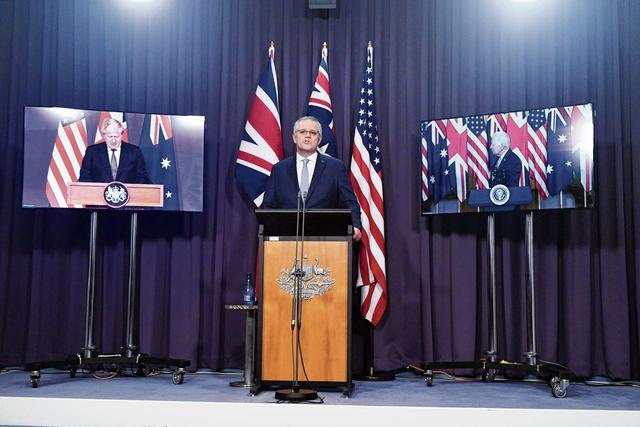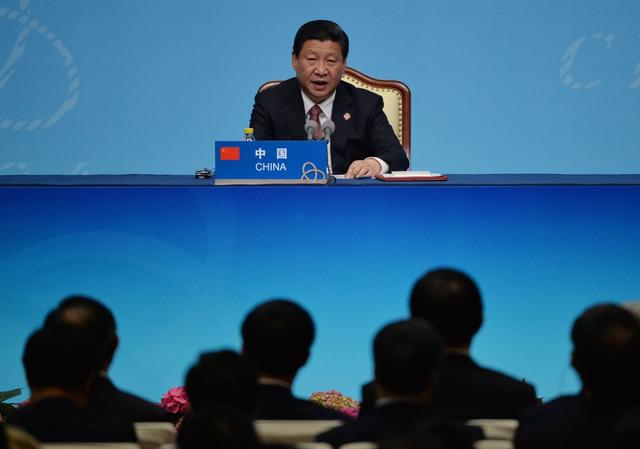周波:多重推力塑造中国蓝水海军
导读:日前,清华大学战略与安全研究中心研究员、中国论坛特约专家周波,在新加坡《海峡时报》发表评论“What's driving China's push to build up its naval power”。周波表示,随着中美关系日趋紧张及中国利益全球化,中国需要一支蓝水海军捍卫中国主权,保护海外利益,承担国际责任。中国论坛联合观察者网翻译全文,以飨读者。
当下,什么最能代表中国的军事实力?答案是:中国海军。
截至2020年底,中国人民解放军海军有360艘战舰,超过了美国海军的297艘。大概率估计,这一差距将在未来几年持续扩大。
套用捷克前总统哈维尔的说法,中国的海军建设如此迅猛,以至于世界都还没来得及感到惊讶。要知道,在1974年中国海军和南越海军的西沙群岛之战中,中国四艘军舰加起来的吨位还比不过南越海军最大的军舰。
不同于为建立中华人民共和国而立下汗马功劳的中国人民解放军陆军和参加过朝鲜战争的中国人民解放军空军,中国人民解放军海军鲜有战争考验,但现在站到了最前沿。原因很简单——今天中国面对的所有威胁都来自海上。
无论是在台湾海峡还是在中国南海,中国海军都必须为与美国海军的可能冲突做好准备。拜登总统曾表示,美国与中国的竞争将采取“极限竞争(extreme competition)”的形式,而不是冲突;但问题是,如果竞争已经很激烈,那可能就像在距冲突一步之遥处走钢丝。

11月23日,美国军舰再次通过台湾海峡。来源:路透社
美国号称在台湾问题上保持“战略模糊”政策。但自特朗普执政以来,美国政府一直在以各种方式“切香肠”般消除这种模糊:包括强化与台北的交流,派遣军舰挑衅地穿越台湾海峡,以及在台湾部署军人协助军事训练。
因此,北京方面被迫派遣更多军机前往台湾附近,以加大对台湾的压力,也就不足为奇了。在10月31日与美国国务卿布林肯的会见中,中国外交部长王毅警告美国不要执行“假的一中政策”。
如果台湾海峡爆发冲突,中国会尽全力赢得主权保卫战,而且也能打赢。
由于台湾距离大陆只有160公里,美军会从冲突一开始就处于不对称劣势。美国的亚洲盟友们是否会心甘情愿允许美国人使用他们的军事基地,把自家变成战场,也值得怀疑。
在南海,中国海军越强大,就越不可能忍受美国定期在自家门口挑衅。
冷战时期,美苏两个超级大国可以通过明确划定的势力范围来消除冲突,但中美海军在南海没有缓冲区,事故和险情时有发生,例如2001年中美两架军机的致命相撞。

中美撞机事件,又称81192撞机事件。来源:每日头条
在撞机事件中,一名中国飞行员牺牲, 美国侦察机机组人员在海南岛被扣留,美国大使在致信中两次提及“非常抱歉”,事件才得以和平解决。
现在的局面已大不相同。拜登总统最近与中国国家主席习近平的视频会晤时提到要建立“务实与理性的护栏”,但北京和华盛顿之间的互不信任和缺乏战略共识,使得建立“护栏”的空间有限。若再遇到类似情况,缓和危机将比以往更具挑战。现有的少数几个建立信任的措施只是战术安排,难以解决战略上的不信任。
美国能指望AUKUS联盟和Quad四国集团吗?
中国和美国都强调要避免新冷战。但是,如果竞争注定会加剧,美国能指望它在印度-太平洋地区的盟友吗?
无论承认与否,澳大利亚、英国和美国之间的奥库斯(AUKUS)三边安全条约,以及由美国、印度、日本和澳大利亚组成的四国集团(Quad),就是华盛顿难以粉饰的遏制中国的双重手段。
问题是,它们的用处有多大?澳大利亚在AUKUS协议框架下预期获得8艘核潜艇,如果连第一艘都不能于2040年前交付,那么这些潜艇不仅改变不了游戏规则,还会在未来几十年内一直困扰堪培拉。澳大利亚没有核工业,如果这些潜艇必须不时地在他国进行维护,那么澳大利亚的潜艇能力就不可能是完全独立自主的。
四国集团可能发展,但不可能发展成为针对中国的有用的军事联盟。
从根本上说,这四个对话伙伴是否准备牺牲与中国的双边关系,特别是巨大的经济交往,而对华采取敌对的态度?

AUKUS美澳英联盟。来源:NRC
军事上,澳大利亚是Quad一员,也已经是AUKUS的一部分。日本虽然不是AUKUS成员国,但也表态支持。因此印度对中国的态度攸关Quad的生存和发展。但即使印度对中国海军在印度洋的存在感到不爽,它也很难提出抗议,因为解放军在印度洋的所有军事行动,无论是反海盗还是救灾,都是人道主义性质的。中国海军和印度海军不可能在印度洋上发生类似去年6月两军在陆地边境地区的军事冲突。
为全球化中国打造蓝水海军
如果只是为了解决台湾和南海问题,中国海军并不需要这么多舰艇。由于全球贸易约90%是通过海路运输的,而中国是世界上最大的贸易国和最大的原油进口国,所以国际海上通道安全对中国来说关乎命脉。一个全球化的中国必须拥有自己的蓝水海军。
这就是为什么自2008年12月以来,中国一直派遣海军编队在非洲之角附近水域巡逻。在中国海军编队护送的商船中,几乎有一半是外国船只,说明中国在保护自身利益的同时,尽量兼顾国际责任。在亚丁湾,中国一直在与北约、欧盟和美国领导的多国海上力量并肩合作。
中国的目标是在2049年庆祝中华人民共和国成立100周年时建成一支世界一流的军队,这是完全可能的,因为今天的解放军已被许多人视为仅次于美军,而距离目标还有20多年的时间。问题在于,中国会如何使用这支有朝一日可与美国并驾齐驱的军事力量?毋庸讳言,一支更强大的中国人民解放军将更有能力捍卫中国主权。

中国海军医疗船“和平方舟”号。来源:中新社
但中国不像美国,没有传教士般的干预他国内政或管控世界的狂热。尽管有猜测中国将建立“珍珠链”——横跨印度洋的一系列海外军事基地,但迄今为止,中国只于2017年在吉布提建立了一个后勤保障基地。可以说,中国没有兴趣重蹈美国由于帝国扩张致使衰落的老路。
一言蔽之,人们应该如何看待中国海军?
自2010年以来,中国海军医疗船“和平方舟”号巡游世界,已为数十万人提供了医疗服务。这与600年前郑和下西洋的做法步调一致,当时郑和的无敌舰队引发更多的是钦佩,而非望而生畏。
如果说中国最大的驱逐舰“南昌”号代表了中国的硬实力,那么“和平方舟”则传递了另一面信息:大国的实力恰恰在于谦逊。
翻译:中国论坛 蒋绍澄
校译:中国论坛 韩桦
What's driving China's push to build up its naval power
What best represents China's military strength? The answer: its navy.
At the end of last year, the Chinese People's Liberation Army Navy had 360 battle ships, surpassing the United States Navy's 297 vessels. And that gap is expected to widen in the coming years by most estimates.
To paraphrase former Czech president Vaclav Havel, China's naval build-up has happened so rapidly that the world has not had time to be astonished. In the 1974 Battle of the Paracel Islands between the naval forces of China and South Vietnam, the four Chinese warships combined were dwarfed in size by the largest ship of the South Vietnamese navy.
Unlike the PLA Army, which fought to establish the People's Republic of China, and the PLA Air Force, which fought in the Korean War, the least war-tested PLA Navy now stands at the forefront, simply because today, all threats to China come from the sea.
Be it in the Taiwan Strait or in the South China Sea, the PLA Navy has to prepare for possible conflict with the US Navy. US President Joe Biden has said that US rivalry with China will take the form of "extreme competition" rather than conflict; the problem is, if competition is already extreme, it is probably like tiptoeing on a tightrope that is only one step away from conflict.
The US is said to maintain a policy of strategic ambiguity on Taiwan. But since the Trump administration, the US government has been salami-slicing away that ambiguity in diverse ways, including enhancing exchanges with Taipei, sending warships to sail provocatively through the Taiwan Strait and deploying its servicemen in Taiwan to help with military training.
It is not surprising then that Beijing is compelled to increase pressure on the island by sending more military aircraft to fly near Taiwan. In a meeting with US Secretary of State Antony Blinken on Oct 31, Chinese Foreign Minister Wang Yi warned the US not to pursue "a fake One China policy".
Should conflict erupt in the Taiwan Strait, China cannot afford to lose in a war defending its sovereignty. And it probably won't.。
With Taiwan just 160km away from the mainland, the US military will find itself in an asymmetrical disadvantage from the start. It is questionable that its Asian allies will readily allow Americans to use their military bases to turn their homelands into battlefields.。
In the South China Sea, the stronger the PLA Navy becomes, the less likely it will bear with American provocations at China's doorstep on a regular basis.
Unlike in the Cold War where there were clearly defined spheres of influence which allowed the two superpowers to deconflict, there are no buffer zones between the two navies in the South China Sea. Accidents and close calls have occurred, including a deadly collision of two military aircraft in 2001.
The so-called Hainan incident - which led to the death of a Chinese pilot and the detention of the crew of the American reconnaissance plane on the island - was resolved peacefully only after the US ambassador sent a letter in which he said "very sorry" two times.
The situation is far different now. The mutual distrust and lack of strategic consensus between Beijing and Washington leave hardly any room for "common- sense guardrails", in the words of President Biden during his recent virtual meeting with China's President Xi Jinping. De-escalation in a similar crisis will be far more challenging than in the past. The few confidence-building measures in place are only tactical arrangements which can hardly resolve strategic distrust.
Can US count on Aukus and Quad?
Both China and the US have vowed to avoid a new Cold War. But if the rivalry is set to intensify, can the US count on its alliances in the Indo-Pacific?
Admit it or not, Aukus, the trilateral security pact between Australia, the United Kingdom and the US, and the Quad, involving the US, India, Japan and Australia, are Washington's thinly veiled dual approaches in containing China.
The question is, how useful are they? If the first of Australia's eight nuclear- powered submarines under Aukus is not going to be delivered before 2040, the subs will not become serious game changers. Instead, they will haunt Canberra for decades to come. Australia has no nuclear industry. If these subs have to be maintained from time to time in another country, Australia's submarine capability cannot be sovereign.
The Quad could grow into anything other than a useful military coalition against China.
Fundamentally, are the dialogue partners prepared to sacrifice their bilateral ties, especially the huge economic interactions, with China, to go on a hostile footing?
Militarily, Australia, a Quad member, is already part of Aukus. Japan, while not an Aukus member, is supportive of it. Therefore India's attitude towards China is critical to the survival and growth of the Quad. But even if India is not happy with the PLA Navy's presence in the Indian Ocean, it can hardly protest because all the military operations of the PLA in the Indian Ocean are humanitarian in nature, be it counter-piracy or disaster relief. There is no likelihood of a military clash between the PLA Navy and the Indian Navy in the Indian Ocean like the one in the land border areas between the two armies in June last year.
Blue water navy for a global China
If it is only for resolving the Taiwan and South China Sea issues, the PLA Navy does not need so many ships. As about 90 per cent of global trade travels by sea, the security of the international sea lanes cannot be more crucial for China, the largest trading nation and the largest crude oil importer in the world. A global China calls for a blue water Chinese navy.
This is why since December 2008, China has been sending flotillas to patrol the waters off the Horn of Africa. Almost half of the merchant ships escorted by Chinese task forces are foreign ships, a demonstration of how China tries to combine its own interests with its international responsibilities. In the Gulf of Aden, China has been working in tandem with the North Atlantic Treaty Organisation, the European Union and the Combined Maritime Forces led by the US and other countries.
China aims to build a world-class military by 2049 when it celebrates its centenary. This is entirely possible as the PLA today is already seen by many as second only to the US military and there are still more than two decades to go. The question is how China might use its military that will one day be on par with the US military. Of course, a stronger PLA will be better positioned to protect China's sovereignty.
But unlike the US, China has no missionary zeal to intervene in the domestic affairs of others or to police the world. Despite speculation that China would establish a "string of pearls", that is, a series of overseas military bases across the Indian Ocean, China has so far built only a logistical supply base in Djibouti in 2017. It has no appetite to repeat the imperial overstretch that has, arguably, caused America's decline.
So, in a snapshot, how is one to view the PLA Navy?
Since 2010, Peace Ark, the hospital ship of the Chinese navy, has sailed around the world providing medical treatment to hundreds of thousands of people. This is in step with Admiral Zheng He's voyages in the Indian Ocean 600 years ago when his unrivalled fleet invoked more admiration than awe.。
If China's biggest destroyer Nanchang represents the hard power of China, then Peace Ark sends another message: the heft of a great power lies in humility.
Zhou Bo is a senior fellow at the Centre for International Security and Strategy at Tsinghua University and a China Forum expert.
本文系观察者网独家稿件,文章内容纯属作者个人观点,不代表平台观点,未经授权,不得转载,否则将追究法律责任。关注观察者网微信guanchacn,每日阅读趣味文章。






















评论